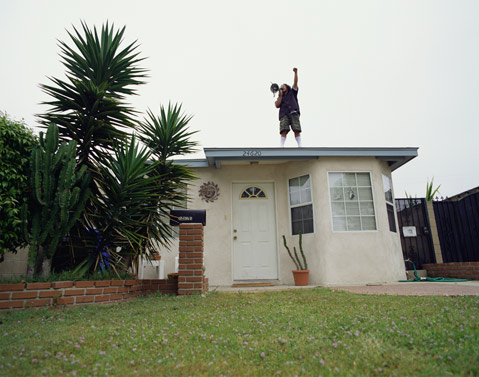Review: Left Coast at the Santa Barbara Museum of Art
Museum Showcases Recent Acquisitions from 2009-2014

What artist wouldn’t want to know the secret to becoming part of a major museum’s permanent collection? While Left Coast: Recent Acquisitions of Contemporary Art, on view through September 14 at the Santa Barbara Museum of Art (SBMA), may not provide a blueprint for aspiring creators, there are plenty of hints and reminders and enough visual and mental stimulation to feed several months of heated contemplation. Curators Julie Joyce (contemporary art) and Karen Sinsheimer (photography) describe the show as offering “an overview of the SBMA’s collecting habits in contemporary art and photography over the last five years,” and the result is both wide-ranging and coherent, with disparate works coming together into a wide-angle snapshot of what’s happening in the art world, particularly here in Southern California.
Hint number one comes in the form of Lari Pittman’s extraordinary 1990 painting “Transcendental and Needy,” which occupies a prominent spot in the first of the show’s two galleries, and reminds us that work collected in the last five years doesn’t necessarily mean work created in the last five years. As part of Pittman’s “Needy” series of paintings, dense allegorical works layered with personal symbolism and dominated by variations on the figure of an owl, this particular work addresses the AIDS crisis and its impact on Pittman’s life, revealing a personal approach to mortality and to historical context that’s one of the show’s most frequently occurring home truths. In an entirely different painterly idiom, yet with a similar suggestion of interiority and menace, there’s UCSB professor Dan Connally’s 2004 abstraction “A Small Fire.” As with Pittman, Connally’s presence here indicates that SBMA curators see his work as part of an oeuvre that will stand the test of time.
How do photographers qualify for inclusion? Some, like Ken Gonzales-Day, Mario Ybarra Jr., and Lyle Ashton Harris, do so by using photographs as one piece in a larger project involving social commentary and self-dramatization. Gonzales-Day’s untitled photograph of two antique busts from the Getty collection riffs brilliantly on the double meaning of the word “profile,” which in this instance implies both the angle from which these faces are seen and the degree to which they fit with the viewer’s expectations regarding facial features and racial identity. Ybarra’s “Go Tell It #1” depicts the artist standing on a Los Angeles rooftop shouting through a megaphone, his clenched fist in the air. The angle of the shot emphasizes the key irony here — there’s no one else in the picture. He’s telling it, but nobody’s listening. The image comes from a period in Ybarra’s career when he was busy unearthing the hidden historical connections that traverse Southern California’s famed tortilla curtain. Lyle Ashton Harris also appears in his own photographs but takes the genre of self-portraiture in another, albeit equally political, direction. His “Americas (Triptych) [Miss Girl; Kym, Lyle & Crinoline; Miss America]” (1987-88), which was first widely seen as part of the notorious 1994 Black Male exhibit at the Whitney Museum of American Art, remains one of the most striking examples of gender and race deconstruction from that period. Expect makeup, nudity, an American flag, and, yes, crinoline.
Lastly, it helps to be truly, incontrovertibly, and iconically great, as can be seen in the works by Jack Goldstein, Ken Price, Mike Kelley, and Llyn Foulkes. Each of these artists has earned a place in the recent canon of major artists, and the museum has succeeded in acquiring not merely representative but truly important works by each of these masters. Goldstein’s untitled painting from 1989, painted just one year before the artist quit making art altogether, is a classic example of the Metro Pictures sublime and looks just as good, if not better, in Santa Barbara than it did in SoHo.



